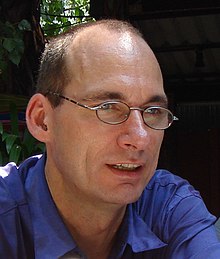Loading AI tools
German sculptor (born 1960) From Wikipedia, the free encyclopedia
Thomas Reichstein (born 24 November 1960) is a German sculptor.
Thomas Reichstein | |
|---|---|
 Thomas Reichstein in Bangkok | |
| Born | 24 November 1960 (age 63) Halle/Saale, Germany |
| Occupation(s) | A German sculptor and artist |
Thomas Reichstein was born in Halle/Saale. Starting as a gardener, he studied landscape architecture at the university in Dresden TU in Dresden from 1982 to 1984. After this he studied fine arts in the sculptor section of the art school in Dresden Hochschule für Bildende Künste Dresden.[1] His teacher was professor Klaus Schwabe. He got his diploma in 1990.
He became a freelance sculptor in Dresden. From 1992 until 1997 he went to Ghana for three months every year to a brass casting village near Kumasi. Applying the lost wax technique, he produced small abstract and ornamental figures. These objects made him well known in Saxony.
In 1995 he started a workshop with the woodcarvers in Neuireland, an island of Papua. He learned to carve mangrove wood in the Malanggan style. One year later he went to Oro province in Papua. He made tapa cloth from the bark of a tropical mulberry tree. With this material and rattan sticks from Vietnam he created his Rattan-Tapa sculptures. He showed them for the first time in the ethnographic museum in Dresden.
As a result, Thomas Reichstein developed a special type of rattan bark cloth – sculptures. In 1997 he won a competition for the Semperoper Dresden for a yearly given award-sculpture. His idea impressed the jury with the balance of abstraction and reality. Thus he found the successful relation to music, singing and dancing the basic elements of the opera in an equal manner. Since then Reichstein received further orders for price-sculptures from politics and economy (e.g. Dresdner marketing price, MTM Award). From 1 January 1998 to 31 December 1998 taught Thomas Reichstein in the Saxon stonemason school in Demitz – Thumitz. He developed the stonework there specific technical basics of design and taught inter alia freehand drawing, sketching and modeling to nature. Since 1999, Thomas Reichstein operates several months a year in a Buddhafoundry in Ban Pong in Thailand. From 1999 to 2005 he created here a rich series of abstract sculptures. Since 2006 he worked there with the German artist Doreen Wolff and since 2010 even with Catrin Große.

Since 2006 he started to develop a big quantity of human figures.

Since 2006, Thomas Reichstein used again reinforces the human figure to. So he created, for example, in 2009 a group of Nereids – the nymphs from the Mediterranean sea, inspired by classical Greek models from the British Museum in London. Figure table image
Thomas Reichstein was 2000–2012 Chairman of the Saxon artists association and 1997–2012 board member of the Federal Dresden artists. 2005 he was Member of the Board of the Association of Visual Artists (BBK) of Germany. Since 2012, Thomas Reichstein is the CEO of the New Saxon Art Association. Thomas Reichstein is father of four children.
In 2006, Thomas Reichstein wins with a digression into the world of geometry. He designed from Platonic, Archimedean and Catalan bodies a Polyeder-Circlesculpture and thus achieves a competition of Saxony for a study academy first place.
The first prize of a competition of Jena gets Reichstein in 2007 for his sculpture "Big Fish" and " Saalewave". These are very directly involved in the redesign of the promenade along the river Saale in Jena. They are especially designed with a safety ground on touching. The overall project receives in 2009 the Thuringian landscape architecture award.
Since 2010, Thomas Reichstein begins a new convolute from life-sized bronze figures, which has grown by 2013 to 25 works. These develop from creations in statuesque appeal to Lucas Cranach the Elder, to freely moving, dance and expressive representations.
Since first May operates Thomas Reichstein with the painter and sculptor Doreen Wolff, a co-operative gallery in the city center of Dresden, 20 Schlossstrasse, Castle Street in which they show only their own works of art.
Seamless Wikipedia browsing. On steroids.
Every time you click a link to Wikipedia, Wiktionary or Wikiquote in your browser's search results, it will show the modern Wikiwand interface.
Wikiwand extension is a five stars, simple, with minimum permission required to keep your browsing private, safe and transparent.